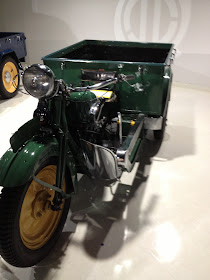The Mazda Museum offers a one-hour guided tour in English every day at 10 a.m. That was the tour we took (big surprise there!). Interesting to note: The American headquarters for Mazda is in Irvine, California, the next suburb over from my home town of Lake Forest. I haven't toured that facility, yet, but after seeing what the Japanese have, I am interested in comparing it to the American headquarters.
When you walk in to the Hiroshima museum, you immediately see four current Mazda models offered in Japan, bright, shiny, lit up and in front of the chrome Mazda logo.
Along one wall were posters expalining different aspects of the Mazda history and branding. The marketer in me was excited about this... I think they havedone a decnt job brandingbecause I easily recognized their logo, blocky Mazda font and catchohrase: "Zoom, zoom!" But, unfortunately, their most memorable American vehicle for me, the Chiclet-shaped Miata was no where to be found.
Mazda and Ford Motors have had a longtime relationship in partnering to produce vehicles. Here is a blast from the past: Anyone remember the Ford Telstar? Yeah, me neither. Probably because I was 7 when this model was produced.
Mazda was founded in 1920 as a cork factory. How a company goes from corks to cars is a story I would like to hear, or read, but since I had to keep up with the group, I do not know how or why that transition took place. The Wikipedia for Mazda wasn't much more helpful.
Somehow Mazda went from corks to machine tools to vehicles, this "three-wheeled truck" being one of the first. Below is a drawing of the Mazda-Go, and below that, a photo of an actual model in the museum.
 |
| This is a long-bed version. |
Of course, like any good auto maker worth its salt, Mazda featured cherry-condition examples of its most popular, or most unusual, vehicles. Here were some of my favorites:
 |
| My friend Yolanda models my favorite colored car. |
For you engineering gearheads out there, Mazda is apparently known for its rotary engines. They are very proud of these engines and I wish you could tell you more about them, but between my lack of interest in the subject and the hard-to-understand-heavily-accented-English of our tour guide, I have nothing. But I did take photos in case I ever found myself interested later.
Mazda is also very proud of this race car, which is powered by one of the rotary engines. Apparently this race car lost the Le Mans 24-hour Endurance Race 13 times before finally winning in 1991. Practice makes perfect... and allows you to then collect dust in a museum.
On our way to the assembly line (which I did not get to take pictures of, unfortunately) we walked through static displays explaining how the Mazda CX-5 SUV crossover was designed, developed and constructed. These are the colors the CX-5 is available in in Japan.
Each new Mazda model goes through a vigorous design and testing process. During the design process, clay is used to make first a 1/5 scale model of the vehicle, and then a full-sized model of the vehicle, including models of certain sections of the interior. I am not sure if other vehicle manufacturers use this same clay process, but it would be interesting to find out.
And, of course, there are the fun crash tests. This car performed perfectly, crumpling the front end and setting off the airbags... at a speed of about 32 miles per hour. Which, in Japan, is a realistic test. There aren't too many surface streets that get over 50 kph, which equates to about 31 mph.
This model was not in an accident. Mazda was simply showing the chassis of the CX-5 and the five different coats of paint each car gets.
Like I had mentioned, we did get to tour one of the four assembly lines Mazda has on its large Hiroshima campus. We were not allowed to take photos, unfortunately. But if you ever have a chance to see an assembly line like this, do it. The line was amazingly synchronized, with almost 200 "stations" where different parts of the cars are installed. From the observation deck we had access to, we saw everything from carpet and roll bars being put in, to windshields and entire dashboard consoles. Everything moved smoothly, flawlessly, with both humans and robots working in tandem so parts arrived to the stations just in time to be installed in the car as it rolled past on the huge conveyor belt. And the coolest part? Seven different vehicles were being assembled. So you may have Vehicle Model A, then a Vehicle Model C right behind it, followed by two Vehicle Model D's. And, somehow, the robots and humans had everything they needed for each different vehicle as the vehicle rolled past. Very fun to watch. The assembly line we watched churns out about 1,000 cars a day.
Finally, we headed back toward the lobby of the museum, first stopping to see the "future" of Mazda. Below is a hydrogen-powered car, which is the direction Mazda's research and development has gone in. They had several other models that were hydrogen/gasoline hybrids, which is a good thing. For all this excitement about hydrogen-powered cars, there is currently no where you can go to refuel with hydrogen. I think they should come up with a system where you fill your car up with water from your garden hose and then a machine in the car separates the H2 from the O and you chug along on your merry way. But, like I said before, I am no engineer, so this may not be possible.



























No comments:
Post a Comment